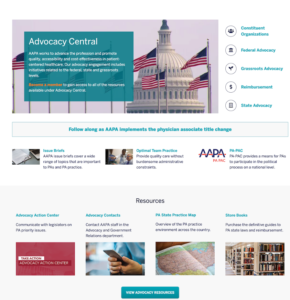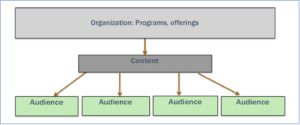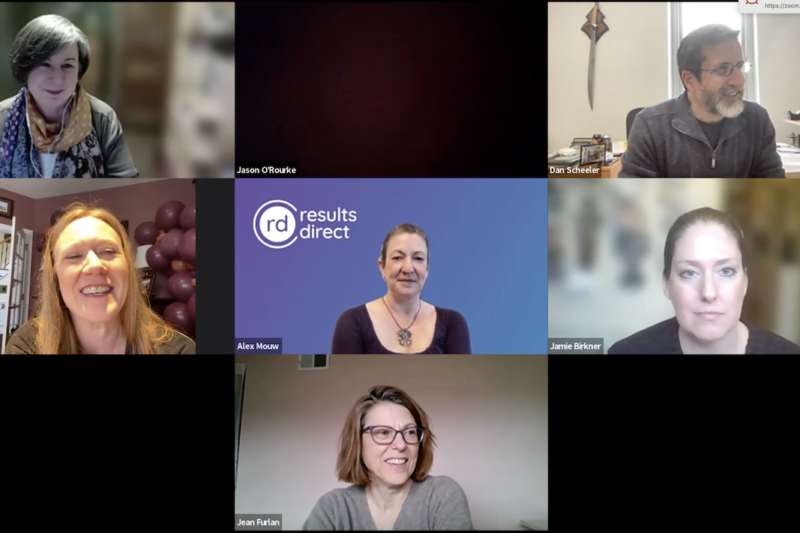To measure the success of the content in your organization's newsletter, don't just stop at…
TL; DR (also known as takeaways):
- Your culture may be standing in the way of more effective content
- You can increase your organization’s content strategy maturity
- Better content practices = more successful content = more successful audiences = more successful organization
Organizations create a LOT of content. “Content” means core work like industry guidelines, conference sessions, programs, courses, codes of ethics, original research, etc. It’s key to distinguish this type of deeper, more valuable content from marketing-focused or informational content, whose goal is to draw people to the organization’s core content.
Core content can be successful only if the organization publishes it in a way that resonates with the audience. This typically requires that:
- Content is displayed by topic rather than department
- Every piece of content has an explicit audience and a measurable goal, tied to the organization’s strategy
- Senior staff supports cross-departmental content planning and creation
- Every department shares an understanding of who the organization’s top-priority audiences are and what they want from the organization
These are hallmarks of a content-first culture. Not so coincidentally, they are also indicators of the organization’s content strategy maturity.
What it looks like when content comes last
When content comes last
- The organization’s staff members don’t understand that content is the way their work is manifested in the world
- Staff members in various departments plan and create content separately
- Content doesn’t have a clear audience or goal
- The organization creates content only for a specific segment for a specific reason
- Content is written with internal jargon, rather than the audience’s terms
- Content work is an afterthought for subject-matter experts because it isn’t part of their job descriptions
Here is a visual depicting this type of thinking:

When organizations operate in this type of model, each department or product line basically operates like a single-entity separate organization, maybe with very loose connection to other departments or product lines but maybe not. They don’t know or build on what others create and don’t connect their work or content with others’ work or content.
This type of thinking is evident in org-chart-based websites:

![]()
The audience is likely to come to the website with questions: Where and how can I learn about a specific issue? What do I need to do in order to succeed in my profession? That information is not easy to find!
We see similar challenges with websites that highlight categories of information without giving any indication of what is in there:

What issues does this organization work on or advocate for/against with any level of government? Why are those issues important to the audience? We don’t know by looking at this page.
Other examples when this type of internal culture is evident to audiences:
- “Subscribe to ‘our newsletter,’” only displaying the newsletter produced by a single department or division
- Multiple “single sources of truth” about a topic or issue
- Advocacy, Publications, and Resources sections have conflicting information about the organization’s position on a topic
- Old press releases paint a picture of an industry that is no longer true
- Clinical guidelines not linking to the organization’s own resources
There are business consequences from this type of approach:

- Audiences don’t know what you have for them
- Audiences don’t know what you do for them
- Audiences don’t see the breadth of products and services you offer
And most important of all,
- Audiences don’t use the products and services that would benefit them most
These content problems are caused by people problems:
- Staff skills, time, motivation, and accountability
- Internal siloes
What content-first looks like

In a content-first organization, everyone understands that their work is part of the organization’s mission and value. The organization sees itself as a single entity with a myriad of products, programs, services, information, resources, and tools – which we shorthand as “offerings.” Those offerings manifest themselves in the world as content, and the organization shares that content with its audiences.
This approach requires connection and collaboration. Characteristics of this philosophy include:
- Everyone agrees on the most important topics
- Everyone records their plans in a central content calendar
- People collaborate where they can, connect always
Underlying these characteristics is a common understanding of the audiences that are most important to the organization – who they are and what they want from the organization. In our experience, the best way we know to create this common understanding is by convening a cross-departmental internal team and creating empathy-based personas, then validating the personas through focus groups. See “How to learn what your audience wants/needs” below.
If all content creators have a common understanding of the audience,
- Everyone knows who the most important audiences are
- Everyone understands what those audiences want from the organization, and how their work can deliver that
- Everyone has the time and skills to write their content in audience-ready terms
In an organization with an advanced level of content strategy maturity, content strategy is one of “the way things work” in the organization. This a journey – no organization gets to this level by accident! In 2019, I co-led a study about association content strategy adoption and maturity; we found that only 18 percent of organizations were at the advanced level of maturity.


The study is available for download at http://bit.ly/assn-content-strategy-report (free for ASAE members, $10 for others).
You can calculate your own organization’s content strategy maturity by using this free simple assessment tool: http://bit.ly/contentstrategy-maturity-assessment
How to learn what your audience wants/needs – and why
- Brainstorm – draw on what you know already
- Cross-departmental participation is key
- Think about people you know personally at similar life stages
- Ask them
- Surveys
- Focus groups
- Compare your qualitative research with quantitative data
- What are they looking at (and not looking at)
- What are they contacting you about
- What are they searching for
Read more about understanding audience needs.
Plan content collaboratively, with users’ needs in mind
To do this, study the audience information you’ve collected about content topics, formats, and frequency – and share the takeaways with all content creators.
Invite all content creators to brainstorm together about how to address those needs through the offerings they create. This may be through in-person sessions or online collaborative tools including digital whiteboards. Help folks make some decisions together:
- What topics or formats should the organization create more of? less of? stop doing altogether?
- What would success look like for various kinds of content?
- How can we make it easier for our audiences to find the content we create?
Help the creators make connections across offerings, whether that is creating content together or cross-linking their individual offerings.
Finally, start mapping out the plans in a content calendar that is stored in a central place where everyone can see it. Here are some ideas and tips about content calendars. Even though dates may need to shift for a myriad of business reasons, it’s important to keep track of content plans.
Advancing culture through content strategy
This type of collaborative work among content creators, informed by user needs, is what advances an organization’s content strategy maturity and improves its culture. In a mature organization, the collection of offerings is presented like a piece of orchestral music, with each department producing individual pieces that add up to a rich, balanced experience.
How to start your journey to a content-first culture

Only a small percent of organizations are “there” already – for the rest, it is a journey, one that you can start today.
We organized the content strategy tactics identified in the maturity study into seven groups:
- Strategy
- Content operations
- Content quality
- Audience understanding
- Content planning and marketing
- Taxonomy/metadata
- Content structure
Think about your organization’s biggest pain points, and map out your own crawl-walk-run journey.
So we end this article where we started, with the takeaways:
- Your culture may be standing in the way of more effective content
- You can increase your organization’s content strategy maturity
- Better content practices = more successful content = more successful audiences = more successful organization
Download a presentation version of this article (PDF, 14 MB)
Content Company helps content-rich organizations address these challenges. Please reach out to set up an initial discussion about how we can help yours.



This Post Has 0 Comments